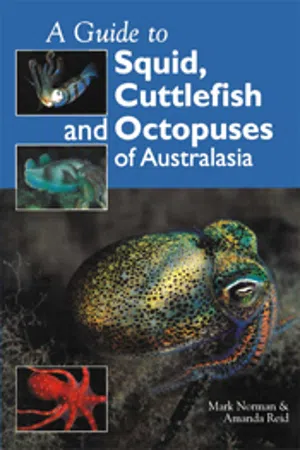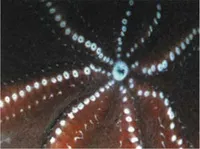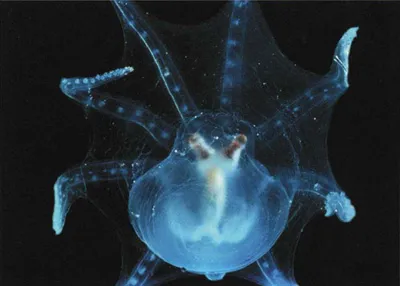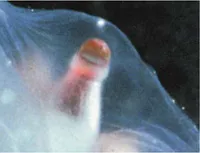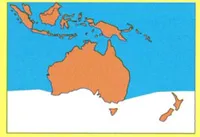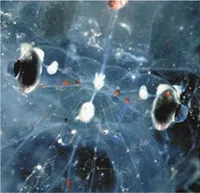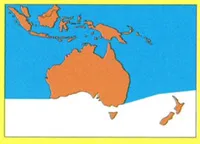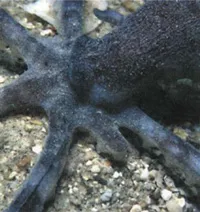![]()
DEEPSEA FINNED OCTOPUSES (FAMILY OPISTHOTEUTHIDAE)
Above: Opisthoteuthis grimaldii from the Atlantic. (Photo: M Vecchione) Below: Sucker rows and cirri from a specimen from off southern Africa. (Photo: M Norman)
The finned or ‘cirrate’ octopuses occur in the deep waters of all oceans. These soft gelatinous octopuses can reach a total length of more than 1.5 metres and have been recorded to depths of more than 5 km. Little is known of these octopuses in Australian and Asian waters. Deepsea Finned Octopuses have a pair of fins on the mantle and a single row of suckers along each arm, bordered by rows of sensory fingers (‘cirri’). The webs are very deep and these animals often swim with arms and webs spread out, using the fins and jetting to move along. The finger-like cirri may be used to sense the electrical or chemical traces of potential prey.
They are the only octopuses which do not brood their eggs. Eggs are laid in a creased casing and attached to rocks. The males of some species have specially enlarged suckers which may be used in courtship or mating.
IDENTIFICATION Recognised by fins and rows of fine cirri on either side of suckers. Lack light organs and filaments in pits as are found in Vampire Squid.
![]()
TELESCOPE OCTOPUSES (FAMILY AMPHITRETIDAE)
Telescope Octopus | Amphitretis pelagicus |
Above: Amphitretis pelagicus has transparent flesh and a single row of suckers. Below: It also has tubular telescopic eyes. (Photos: R Young)
The Telescope Octopus occurs in the open waters of the Indian and Pacific Oceans and the southern Atlantic Ocean. This small free-swimming animal reaches a total length of about 20 cm and is the only octopus in the world with tubular telescopic eyes (left), joined together at the base. These special eyes presumably search the waters above for the silhouettes of their prey, much like the hatchetfishes. This species appears closely related to the Glass Octopus. The underside of the mantle is fused to the funnel, forming two slit-like openings to the mantle cavity.
Nothing is known of life cycle of this species. There is some evidence that smaller animals (less than 30 mm long) occur in shallow waters (<150 m), while larger animals have been collected down to depths of 2000 metres.
IDENTIFICATION Easily identified by telescopic tubular eyes and two slit-like openings to mantle cavity. Single row of suckers on arms.
![]()
GLASS OCTOPUSES (FAMILY VITRELEDONELLIDAE)
Glass Octopus | Vitreledonella richardi |
Above: Vitreledonello richardi has a cigar-shaped digestive gland (liver) which it keeps vertical to reduce its silhouette from below. Below: The optic lobes of its brain are stalked, and situated close to the eyes. (Photos: R Young)
The Glass Octopus is a strange free-swimming octopus that lives in the open waters of tropical and subtropical oceans. It reaches a total length of about 45 cm and has been caught in trawl nets in all oceans of the world from surface waters to over two kilometres deep. It spends its life in midwater, never touching the sea floor. Its transparent form probably makes it harder for predators to see. Even its brain is small and hard to see (right).
Little is known of reproduction in this octopus. The male has single enlarged suckers on the arms beyond the web margins and the female is thought to brood her eggs in the space formed when her arms are held together.
IDENTIFICATION Transparent form, rectangle-shaped eyes and single wide opening to mantle cavity. Single row of suckers on arms.
![]()
BENTHIC OCTOPUSES (FAMILY OCTOPODIDAE)
Banded String-arm Octopus | Ameloctopus litoralis |
Above: Ameloctopus litoralis feeds by poking its long arms down crevices and under rubble to catch small crustaceans and fish. Below: This individual has discarded one of its arms. (Photos: M Norman)
This small species has the longest, thinnest arms (relative to its body size) of any Australian octopus. Its arm span can exceed 30 cm. It lives on intertidal mud and rubble flats, emerging at night low tides to feed. It is able to drop its arms as a decoy to predators, the discarded arms continuing to writhe for up to 5 hours. Meanwhile, the animal crawls away and grows new arms. This octopus is one of the few shallow...
